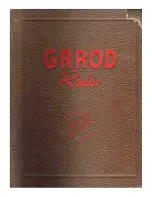
Your radio has a 12 pin connector for the speakers, power, and options. See illustration below for more details. There is one
red
(fused) wire. This is the main power input. It should be connected to the 12 volt Accessory circuit. There is a
green
wire that is used
for the dial light. It should be wired to the dash light circuit ahead of the dimmer rheostat so that the radio lights come on when the
other gauge lights are turned on. The wiring for the front speakers includes a
blue (+)
and
violet (-)
pair for the left front speaker, and
a
gray (+)
and
white (-)
pair for the right front speaker. Each
front
pair will have a
yellow
band around it. The rear speaker wiring
also has a
blue
(+) and
violet
(-) pair for the left rear speaker and a
gray
(+) and
white
(-) pair for the right rear speaker. Each
rear
pair will have a
green
band around it. Your system may not use all of the speaker connections. Be careful to tape up any unused wires
where they cannot touch anything. The
orange
wire is a switched 12 volt output used to provide power for options like remote turn-on
for power amplifiers, power antennas, etc. Do not use it to power loads greater than 4 amps. The
black
wire is the system ground. This
wire should be connected to a solid chassis ground. The Bluetooth
®
microphone is built in. No external wiring is required.
The
ANTENNA
jack is located beneath the wiring harness exit. It will accept your original antenna plug.
The
AUX. INPUT
jack in the upper right is a standard 3.5 mm stereo jack. It is provided to allow accessories like MP3 players to be
active when not using Bluetooth
®.
To switch to the auxiliary input mode, tune the radio to the extreme low end of the dial in either
band. (Hint: Set a pushbutton at this point to allow rapid switching). The radio will resume playing when you tune towards the middle
of the dial. The volume, tone, and balance controls will be functional in the AUX mode, but the alternate fader control will not be
accessible. The AUX Input is shared with Bluetooth
®
connected devices. Bluetooth
®
always has priority and will override any Aux
input. If an accessory is powered by the
orange
wire the accessory will turn off when the radio is turned off. You should adjust the
accessory audio level to match the level of the radio. Check the option instruction manual for how to set the audio level.
When you receive your radio it is setup for North American channel spacing. You can change the frequency by holding down the
middle pushbutton while the power is off and while continuing to hold down the middle pushbutton turn the radio on. You will notice a
green light in the center of the dial. The radio will scan through the local stations and determine which frequency to use for AM and
FM. These changes will be permanently stored until they are changed again by repeating the steps above. The AM broadcast band in
the Americas is 530 to 1710 kHz in 10 kHz steps, and for all of Europe, the UK and Japan it is 531 to 1629 kHz in 9 kHz steps. The
FM broadcast band in the Americas is 87.5 to 107.9 MHz in 200 kHz steps, and for Western Europe and the UK it is 87.5 to 108.0
MHz in 100 kHz steps. Japan and Eastern Europe FM frequencies are not compatible with this receiver.
Each time the radio is powered on it will perform speaker diagnostics to determine the number of speakers that are connected
.
In a 3 or
4 speaker set up the balance and fader controls work as described. In the 2 speaker position the 2 front or 2 rear speakers will work
with the balance control but there is no fader. In the 1 speaker position neither the balance or fader controls have any effect. In this
setting the receiver and the aux inputs operate in mono mode so that the information from both the right and left channels will be heard
in the single speaker. The stereo indicator will not function.
Below the auxiliary jack are 5 color-coded RCA jacks. These are line outputs for an external power amplifier. The Left (white) and
Right (red) jacks are stereo line outs, and the black one is for a sub-woofer amp input. To add an amplifier to your setup: With the
radio turned off hold down the center pushbutton. Turn the radio on and release the pushbutton. You will notice a green light in the
middle of the dial, after 7 seconds it will turn red. Once it begins to blink red if you would like to add an amplifier press the second
pushbutton. The light will flash green to show an amp has been added. To deselect an amplifier from the setup press the 4
th
pushbutton
and the light will flash red. Once you have made your selection press the first pushbutton to return to the radio. You must make a
selection within a few seconds or these setting will not be saved.
Note: If you program the radio to have an amplifier the fade and balance controls will be active.
Specifications
11-16 Volts DC Negative ground only
Output: 180 W. RMS (45 W x 4 speakers @ 4Ω 14.4 V, 1 kHz)
10 Presets (5 AM, 5 FM) Digitally tuned w/analog display
Dimensions: 8.75” W x 2.55” H x 2.75” D (behind dash)
3.5mm stereo input jack, Standard (Motorola) antenna jack
Left, right and sub-woofer outputs use standard RCA jacks
Bluetooth
®
3.0+EDR, Built in microphone for HFP, HSP, A2DP
Memory retention (presets and user settings) more than 40 years
Visit www.radiosforoldcars.com/bluetooth for more information on how to use all of the Bluetooth
®
options
in this radio or click on the QR code. The
Bluetooth
®
word mark and logos are registered trademarks owned
by Bluetooth SIG, Inc. and any use of such marks by Antique Automobile Radio, Inc. is under license.
Other trademarks and trade names are those of their respective owners.
(2)






















